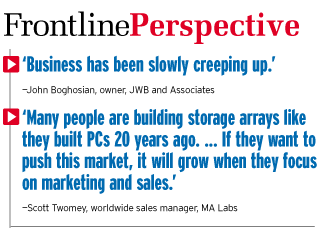Serving Up Storage

Published for the Week Of October 4, 2004

he storage market is booming as content management, e-mail archiving and other applications continue to drive the amount of storage capacity required by customers. Can custom-system builders tap into this growing arena?
Some are. About 44 percent of system builders in the CRN Fast-Growth System Builders survey in June reported that they were building storage devices, up from 37 percent the prior year. And those that did, on average, reported building about twice as many storage units in 2003 as the prior year.
As custom server business has grown rapidly over the past two years, it only makes sense that storage, to some degree, would follow. Still, a storage market in the system builder channel has been slow to develop. Storage units still comprised only 2 percent of all units built by system builders last year, and few were reporting significant volumes.

But for system builders looking to add storage to their custom-system menu, storage arrays and appliances are gradually providing a new business opportunity with margins that can rival servers. Success, though, depends on finding the right customers and applications, solution providers say.
And those distributors and custom-system solution providers that are building storage arrays and NAS appliances are typically not aiming at a broad market, but rather are attaching custom storage to their server sales.
| AD | |
|---|---|
| id | unit-1659132512259 |
| type | Sponsored post |
About half of the servers sold by Tangent Computer, a Burlingame, Calif.-based solution provider, include an external direct-attached RAID subsystem, said Chris Pirvan, director of engineering. “Customers who buy servers ask for additional storage,” he said. “So we know what [the arrays] hook to.”
Many of Tangent’s storage arrays are bundled with Unix- or Linux-based servers built for video surveillance providers, said COO Mike Zabaneh, adding success in the custom storage space came from looking for areas where storage is growing fast but competition isn’t.
“We saw [the surveillance] market early and got well-known,” Zabaneh said. “Prices in this space have moved out of this world. Now we need to find new areas like this.”
Minneapolis-based Reason, meanwhile, has found a niche building direct-attached arrays and NAS appliances for the Geowall Consortium, a group that develops 3-D imaging systems for the education, medical and oil- exploration fields. “These chew up terabytes of storage and has driven us into Linux clustering,” said Dominic Daninger, vice president of engineering at Reason.
Increasing capacity requirements are pushing customers of Dex Computer Center, Poway, Calif., to increase their orders for custom-built storage systems, said Jim Kiesow, owner and manager.
In particular, Kiesow said many customers have recently started looking to him for custom storage boxes to handle their growing e-mail archives. Engineers are also interested in customized storage for projects that generate ever-larger volumes of data.
Distributors are also angling for a piece of the custom storage market. MA Labs, San Jose, Calif., for instance, builds about 2,000 arrays for solution providers per month and is watching that business slowly grow, said Scott Twomey, worldwide sales manager.
Another San Jose distributor, Bell Microproducts, gives solution providers a choice of custom-built arrays, said Phil Roussey, executive vice president of enterprise solutions. The distributor builds arrays under OEM contracts for clients needing at least 10 units per month, and it will custom- configure arrays using branded or unbranded chassis for solution providers as needed. The arrays can be tuned for applications such as high-bandwidth video streaming, he said.
While many system builders are seeing their custom storage business grow, a few are watching it dwindle. Media Integration, Soquel, Calif., builds arrays mainly for its server customers but has been building fewer over time, said Charlie Cohen, sales engineer. The company uses controllers from Infotrend in its arrays. However, since Infotrend is now also building arrays, Media Integration finds itself more often reselling that vendor’s prebuilt models and just stuffing them with hard drives, Cohen said.
The only time Media Integration builds its own arrays is when its financial or media customers have special requirements, such as a SCSI RAID array with four or five host ports. “No one makes them like that,” he said.

New technologies, including Serial ATA (SATA) hard drives and Microsoft’s Windows Storage Server 2003 operating system for NAS appliances, are helping to drive the custom storage business.
Microsoft has several channels for its Windows Storage Server 2003 operating system, among them 19 large OEMs, storage integrators and system builders, including EMC, Hewlett-Packard, Dell, Coastline Micro, CDW, Maxxan, AMS Storage and Inline, said Marcus Schmidt, senior product manager for Microsoft NAS solutions.
Smaller integrators can build NAS appliances with the operating system by acquiring it from four embedded software distributors, including Arrow Electronics, Melville, N.Y.; Avnet, Tempe, Ariz.; Bsquare, Bellevue, Wash.; and VenturCom, Waltham, Mass.
MA Labs is already building NAS appliances based on Windows Storage Server. And Seneca Data, a system builder in Syracuse, N.Y., has been offering a Linux-based NAS appliance and more recently a Windows Storage Server-based NAS appliance. Seneca Data is initially sourcing the appliances from a third party but is licensed by Microsoft to build its own versions. “We will probably start building them by year-end,” said Chuck Orcutt, business development manager for servers and storage.
While Redmond, Wash.-based Microsoft offers incentives and training on Windows Storage Server similar to its other operating systems, the company has not been as aggressive in pushing it in the custom storage channel as others have been with Linux, MA Labs’ Twomey said.
Smaller solution providers that build their own NAS appliances typically modify their servers with either Linux or some flavor of Windows to build NAS appliances. For instance, JWB and Associates, an Atlanta-based server builder, occasionally builds NAS appliances using Windows Server 2003 or Windows XP, said John Boghosian, owner. The company also builds a few RAID boxes using Windows Server 2003. “Business has been slowly creeping up,” he said.
The other key new technology for storage builders is the abundance of SATA hard drives, which in the past six months have become available in volume. They offer lower cost and higher capacity than SCSI drives.
Dex Computer Center builds external arrays using a StoreCase chassis combined with Intel controllers and either Seagate SCSI drives or Western Digital SATA drives. Dex Computer Center’s engineering customers still prefer SCSI drives because of concerns about the reliability of SATA drives, which are still relatively new to the market, Kiesow said. Small businesses prefer SATA because of cost, while Exchange users can go either way, he said.
Reason also builds SATA-based and SCSI-based arrays for small and midsize businesses. Daninger said that his SATA-based array business is growing as customers learn to appreciate how SATA hard drives can be hot-swapped and how the thin SATA cables enhance cooling within the array.
One way solution providers can grow their custom-built storage system business is to focus less on building in small quantities and work more with third-party builders, Twomey said. “Many people are building storage arrays like they built PCs 20 years ago,” he said. “My PC is better than yours, my NAS is better than yours. If they want to push this market, it will grow when they focus on marketing and sales.”